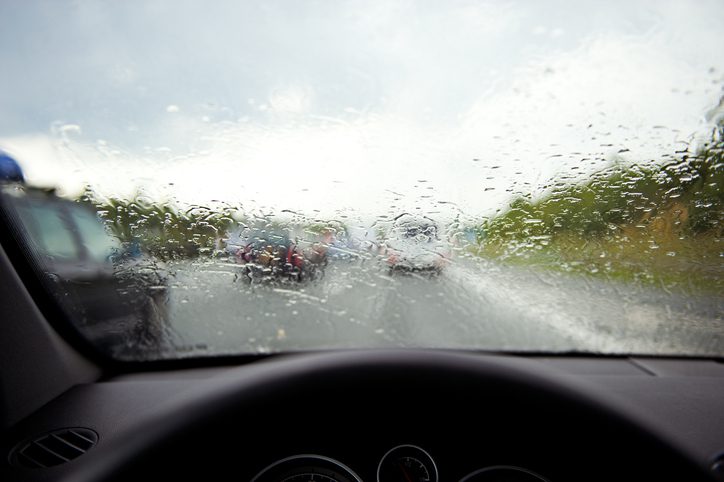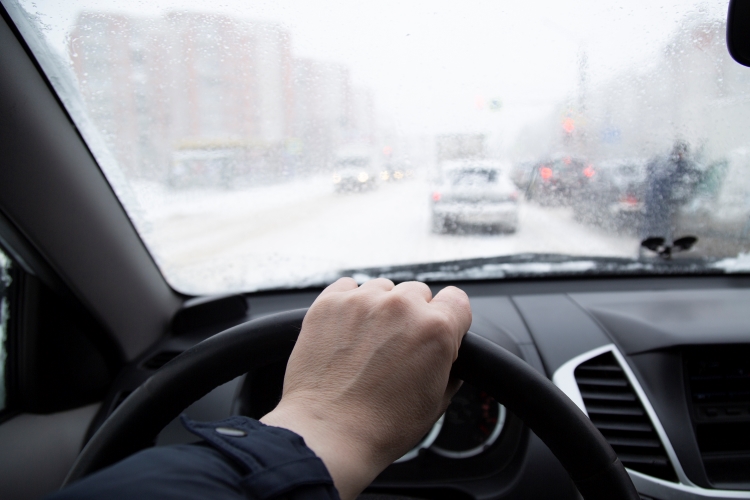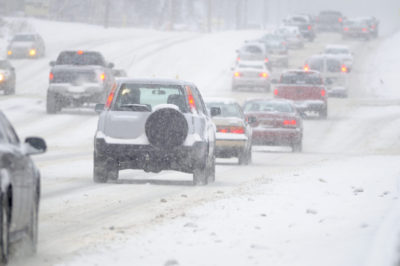Purchasing an electric or hybrid vehicle isn’t the only way to green driving. Simple changes to your vehicle and driving habits can help reduce pollution. Learn some of the easiest ways you can help make your car greener and safer, while saving some money at the pump.
Green Driving Tips

Changes to Your Car to Improve Fuel Efficiency
The following alterations and repairs can help make your car greener. If you are not comfortable making these alterations on your own, ask a mechanic to make them at your vehicle’s next servicing.
1
Check Your Tire PSI
The pressure in your tires impacts your fuel economy.
On average, every 1 PSI drop reduces gas mileage by 0.2%. Tires inflated to the correct PSI can increase fuel economy by 0.6 to 3%.
Never inflate your tires to the maximum PSI printed on the tire. Instead, look for your car’s tire PSI sticker. You can find this in the driver-side door jam or the owner’s manual. This sticker has the correct PSI for your vehicle’s tires. Note that the front and back tires may have different optimal pressure levels.
2
Use the Correct Oil
Be sure to check what grade motor oil your vehicle needs.
Using the correct oil in your vehicle can improve your fuel economy by 1 to 2%. The wrong oil can lower your gas mileage in an equal amount. Don’t use “high-performance” oil that isn’t a match for your vehicle. Also, use “energy conserving” oil when possible. Energy conserving oil contains friction-reducing additives. These additives can help improve your vehicle’s fuel economy.
3
Clean Out Your Trunk
Added weight in your car can decrease your vehicle’s fuel economy.
An extra 100 pounds of cargo can reduce your vehicle’s fuel economy by 1%. Rooftop cargo containers and racks can reduce fuel economy even more, sometimes by as much as 25%. Be sure to remove roof racks and storage containers when not in use or switch to a rear-mount cargo box. Rear-mount cargo boxes still reduce fuel economy, but only by 1 or 2%.
4
Should You Change Your Air Filter?
It is often recommended that you change your air filter to increase fuel efficiency.
If your car predates the 1980s, then it most likely has a carbureted engine. If it does, changing your air filter can increase fuel efficiency and acceleration. Most cars manufactured after the 1980s have fuel-injected, computer-controlled engines. Changing the air filter in these cars may improve acceleration but not gas mileage.
Driving For Better Fuel Efficiency
Simple changes to driving habits can improve your vehicle’s fuel efficiency. Most of these changes will also help increase safety for you and others on the road. Best of all, you don’t need a mechanic to start reaping the benefits.
5
Don’t Drive Aggressively
Aggressive driving is operating a vehicle in an unsafe and erratic way.
This includes fast acceleration, short stopping and revving your engine. Aggressive driving can lower your gas mileage by as much as 30% when driving on the highway. If you drive aggressively in stop-and-go traffic, you may see a reduction in fuel economy by as much as 40%.
You can break the bad habit of aggressive driving. Here are a few tips:
- Maintain three seconds of distance between your vehicle and the vehicle in front of you (or more if the weather is bad). If the vehicle in front of you passes a tree, it should take three seconds before you pass that tree. This will help ensure that you have enough time to adjust speeds or stop in response to the driver in front of you.
- Try to roll to stop signs and red lights. Don’t continue accelerating and then stomp on your brakes. This will wear out your brakes much sooner and reduce your miles per gallon.
- Install a driver feedback device. These devices track your driving habits and can help you improve your driving behavior–and therefore, your fuel economy.
6
Use Cruise Control
You can help improve your gas mileage by using cruise control on long stretches of driving.
Cruise control is ideal if you’re traveling on the highway for a long distance and there are very few cars around. It’s not recommended to use cruise control on hilly terrain. This is because the vehicle will have trouble navigating the hills and it will waste more fuel.
Some newer vehicles are being equipped with updated cruise control devices. These devices maintain distance between your car and the car in front of it. This will slow down your vehicle as it gets closer to the vehicle in front of you. The device will then adjust to and maintain the same speed as the vehicle in front of you.
7
Drive 50 Miles per Hour
Fuel economy plummets when your vehicle accelerates past 50 to 60 mph.
For each 5 mph over 50 mph that you drive, you’ll pay, on average, $.16 more per gallon of gas. Speeds below 50 mph all seem to have the same fuel efficiency. Driving 40 mph on back-roads may help you save on gas compared to driving 65 mph on the highway.
8
Roll the Windows Down or Use the AC?
There is much debate over the fuel efficiency of rolling your windows down or turning on the AC.
Some people say rolling your windows down and turning the AC off helps improve mileage. This is because your vehicle is not using energy to run the AC. Other people say it’s best to roll the windows up and turn the AC on. Doing this reduces drag. Some people will say to keep windows down and AC off at low speeds and turn the AC on and roll the windows up at high speeds.
What Is the Best Green Driving Option?

A test performed by General Motors and SAE gave a conclusive answer. The test found that AC off and windows down is always more fuel-efficient than windows up and AC on. It didn’t matter what speed the vehicle was driving at. Windows up and AC off, however, is still by far the most fuel-efficient option for driving.
How Fuel Efficient Is Your Car?
Find and compare the fuel economy on cars from 1984 to the present at fueleconomy.gov.
Driving safely and spending less money at the pump are two of the benefits of making your car greener. You can also enjoy knowing that you’re helping to reduce CO2 emissions and pollution. Talk to your mechanic about ways to increase your vehicle’s fuel efficiency and be sure to practice fuel efficient driving habits.
Want to reduce your environmental footprint? Learn how to become a zero-waste household.







Idling your car costs money! When not using your car for transportation, do not idle.
Instead of “warming up” your car, drive your car to circulate fluids more efficiently.
Dress warmly in winter instead of using your heater. Car heaters use additional gas.
Use your window defrosters when required for safety.
I love the Hartford. They always take the time to help me reduce the cost of my auto insurance.
All of these comments were interesting to read, and mostly simply are not applicable to my car: a 1996 Z28 convertible (305 hp). A recent scare (brakes master cylinder) made me contemplate something less than 27 years old. Without a CD player. With a dash that looks like a pinball machine. Fortunately, the repair was (after a week) successful. So, Zuckerbaby and I are on the road again, where the highway speed limit is 75. If you’re driving 75 mph you are in the slow lane. It all depends on where one lives.
I drive a duramax diesel 2500 with exhaust brakes. I use the exhaust brakes to s;low at all time is available to me. I now have over 104000 miles on the original brakes. I also use the cruise control when the situation presents it’s self and get up to 21 plus per mile.
No it’s not illegal to drive below the posted spd limit. The posted spd limit is the maximum spd allowed. It is however illegal to drive above the spd limit
Several other options
I drive a VW GTI (sport model – YESSS). One of the driving options is the engine-off on full stop and engine-on with foot off the break. The car is made in a country where gas is about 2+ times or more than in the US and where take home pay is about 25% less, so gas costs – OUCH. If needed, I can turn the feature off but I don’t. Helps at long traffic lights or slow drive through.
I changed work to work from home. Employer likes it because I’m at work more of the time. I also don’t drive to or from work which I like.
Use Google maps, Apple maps, built-in GPS or just look at a map. Takes out the “I know a shortcut – but it takes longer” problem. Years ago I drove home and it was 15 miles – 30 minutes. Finally took the time to look at a map. After that it took 4 miles – 5 minutes.
Heard someone years ago complain about how terrible electric vehicles were. After I thought about it, the reason was, to some extent, valid. A large percentage of the cost of gas is for taxes. That is, road tax which is a use tax to pay for roads. To my knowledge, that is major source of funding. Only those using the roads pay for the roads. That is, except for the electric cars. Something to think about when you hit the next pot hole or bridges that need to be repaired but can’t be fixed because of funding. PS – I’m all in favor of electric and next car will probably be plug-in.
If you want the best mileage, lowest carbon footprint, may we need to get rid of the A/C, return to non-electric and non-opening windows, no radio, non-electric adjusting seats or heated seats, smaller engines to go no more than 50 MPH all to reduce weight and improve mileage. OHH, NON. Forget this last suggestion. Cool and crusin’ at 65.
If you drive under 50 miles an hour on a 70mph freeway, you can be arrested for obstructing traffic.
It’s not feasible to drive with open windows in my Southern California desert area, where temperatures soar to the low 100s and blowing sand can get in one’s car and into one’s eyes.
Informative piece. Myth Busters at one time did a fuel efficiency comparison and said just the opposite–windows up AC on, but it appears new testing shows that was incorrect.
I knew most of this but the debate of windows down/ac. It was a good service
Plan Your Trips to the Store – try to get as much done in one trip at a time. And, Moderate your braking and your acceleration. Give yourself room between you and the next vehicle – never crowd any vehicles bumper.
Wow I didn’t know that about the air filter. I guess my local car repair shop just tries to make money off me every 6 months or so.
Thanks for the tips!
How helpful is it to use the “Econ” button? Does it really save on gas mileage?
A critical safety RULE – NEVER use cruise control on wet,icy, slick roads.
Good tips.
I bought a hybrid last year and I now have the best of both worlds. I get up to 70 mpg in the city and up to 57 mpg on long highway drives at 70 mph. I do not have to plug my car in or worry about a charging station on long trips. I even got an offer from my dealership to buy back my car at $1500 more than I paid for it a year ago. I have never owned a car that increased in value. Also, I like the computer which lets me know when I am driving aggressively. This car has too many other safety features to enumerate and the only one it does not have is the side view camera to let me know if someone is in my blind spot. I could have gotten this feature by spending another $11000 on the tricked-out version, but I am too cost concious to do so.
I seem to only get 17 mpg in town, I regularly have my car serviced, is there a way to get better mileage in town?
This is more common with All Wheel Drive vehicles, because of the additional weight of the second drive axle, and the mechanical component’s parasitic drag of that axle because it is never “disengaged” or “free-wheeling”. For reference – an ’80’s vintage Subaru with Part-time Wheel drive would get at least 30 MPG, an ’07 with All Wheel drive gets 15 around town and 20? MPG highway.
No comment at this time. I just wanted to get on your list.
Thank You
Pat Regan
Patrick – Thanks for reading. If you don’t already get it, you can subscribe to our newsletter here. We send it out two times a month.
Helpful, but would have been mores if prefaced with advice to walk, bicycle, etc. or take public transit rather than drive. Many folks don’t even own a car, which costs the average USA household $9000/year (including insurance!).
Whether internal combustion engine, hybrid, or all-electric, the resource extraction, manufacturing, and delivery of a typical USA-made car, produce 40-60% of its lifetime emissions before the first mile is even on the odometer.
Yep–time to back to horses, oxen, mules, etc….yep–it’s time 🙂
Driving a new Toyota Venza Hybrid. All Venza models are hybrids, with a 4 cylinder gas engine. The dash graphics showing your gas mileage quickly illustrates your driving skills, or lack thereof, getting the best mileage. The electric motor can emulate a turbo charger when you want power and you can see the effects on the dash display for the gas consumption. Likewise, on the highway, speeds of 70 + mph are reflected . I have taught myself to drive it like a Prius around town and I can average over 40 mpg. As for use of A/C, it’s not measurable. What is measurable is the effects of cold weather on the hybrid’s battery efficiency (a -2 mpg).
I already drive that way, so I printed it out and give to some of my friends that don’t, maybe it will save a life sometime.
Thanks for sharing, Alma!
Thanks for the info. I always wondered about the window/AC debate. Thank you for clearing that up!
Thanks for reading, Shirley!
Just remember on in city driving and windows down your smelling other peoples exhaust that don’t maintain there veh. Also I drive 20 miles round trip work n home with windows up a/c on and my mileage is 24 to 26 in a mustang a/c compressors are more efficient do a test for a week both ways windows up vs down
Interesting information. Thank you.
Most valuable reminder. Fits into and with what I’d want to transmit to 55 + community to help our environment.
My car has so many new features such as eye-sight cruise control, blind spot monitors, back-up monitoring of people or cars approaching behind me and so much more. I love these items but never assume anything. When are you going to determine these items save lives so when will you pass theses savings onto your policy holders. Have asked that now for last few years and it seems you don’t believe these factors benefits me and you.
Do not let your car run to warm it up.Cars are built to start and go
Good advice except about hybrids and All- electric cars. While possibly green, such cars will costs more than a small efficient gasoline powered vehicle. Even with rebates they will require over 100000 miles to recovery the cost of purchase due to high battery and drive train prices.
There is also still a ongoing debate about the toxic problems associated with the batteries and other components.
I’ve been driving for 60+ years & just learned a couple new tips. Thanks for the info.
Thanks for reading, Virginia!
Thank you for the information! I found it very helpful!!
Thank you for reading Deborah!
I already knew that but thanks anyway.
Very helpful
Thanks for your feedback, Annie!
i agree with all the info put forth.
We appreciate your feedback, David.
VERY HELPFUL—-A REMINDER OF THINGS I HAVE LEARNED & TRY TO PRACTICE. THANKS FOR THIS SERVICE YOU PROVIDE—MUCH APPRECIATED.
Thank you for reading, Kathleen!
In mild weather I drive with the outside air on (no re-circulation) and the sunroof open. No AC. Less drag and cool fresh air.
Great tip for some summer driving, Walter! Thank you for sharing.
Useful info.
Thank you for reading, Al!
Helpful. Thanks.
Helpful info. Thanks.